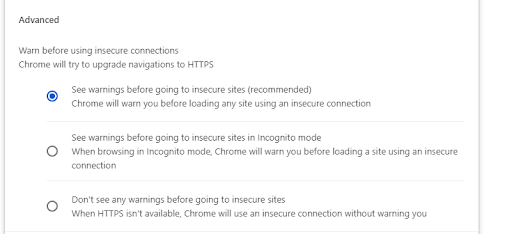Chrome has introduced new settings for its Strict and Balanced mode
Chrome has introduced new settings for its Strict and Balanced mode, allowing users to have more control over warnings for insecure websites. The addition of Balanced mode results in reduced notifications for such sites in Chrome.
Following efforts to enhance the visibility of warnings for hazardous file downloads in Chrome, Google is preparing to launch additional HTTPS security features. This initiative aims to empower users with enhanced control over their online experiences by streamlining current settings and providing more options.
Chrome places a strong emphasis on secure connections (HTTPS) to protect user information. Currently, the browser automatically displays warnings when users navigate to unsecured websites.
Chrome includes three experimental features aimed at handling these warnings. Google has prepared them for the “HTTPS First Mode in Incognito.” To streamline these options, Chrome will introduce two new modes: Balanced and Strict.
Google has introduced the HTTPS First Balanced mode in its new configurations with the intent of reducing the frequency of warnings for sites deemed insecure.
In strict mode, “Chrome will always require user confirmation before accessing a site that utilizes an insecure connection.” Conversely, in balanced mode, “Chrome will request user permission to load public sites with an insecure connection but will permit HTTP connections on private networks.”
The updated settings will do away with the existing tri-state options, replacing them with a toggle for enabling or disabling these modes, accompanied by radio buttons for selecting between Strict and Balanced. This new, streamlined interface enhances user control over their security preferences.
“Revise HTTPS-First Mode settings to incorporate Balanced Mode
This will substitute the previously tested HFM-in-Incognito tri-state settings interface with a new toggle and selection interface. A primary toggle button governs the visibility of the set of radio buttons that lets users choose between “Strict Mode” (the current HFM) and the newly introduced “Balanced Mode” (where the goal is to minimize warnings).
When the primary toggle is switched off, the radio buttons will be concealed, and both strict and balanced mode preferences will be inactive. The newly designed settings interface will come with new text (which is still subject to finalization),” Google commented in a commit highlighted by Windows Report.
Chrome will evaluate the security of websites and decide whether a warning is warranted, depending on the selected mode.
The “Balanced Mode” aims to minimize warnings for trusted networks while still upholding a robust security framework.
Through the simplification of HTTPS settings, Chrome seeks to enhance both user experience and security, allowing users to make informed decisions about their desired level of protection.
In addition to this, Windows users of Chrome will soon have access to a Stylus handwriting feature. The browser's Safe Browsing Card will be enhanced to provide more dynamic safety updates, thereby expediting the browsing experience with quicker checks for website safety. Furthermore, Chrome will introduce an alert for performance problems, accompanied by a one-click button to deactivate tabs that consume excessive resources.


